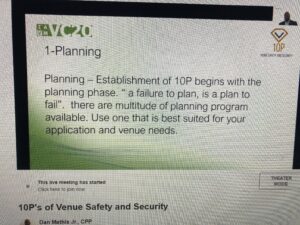By R.V. Baugus
We all like tidy lists full of numbers that we can easily reference and even work into our brains for fast recall. During his VenueConnect presentation on “The 10 P’s of Venue Safety and Security,” Dan Mathis Jr., CPP, Chief of Safety and Security for the Straz Center for the Performing Arts in Tampa, Fla., shared a word for each of those letters and why they are so important to through areas of public safety, liability reduction, and risk mitigation in an easy-to-master format.
“Ten represents the 10 most essential areas of venue safety and security operations condensed into an easy-to-use  format,” Mathis said in beginning his presentation that included a lengthy and engaged Q&A session at the end. “Everybody has plans. There are plans from everywhere. There are private contractors that will come in and develop a plan for you. There’s planned assistance from the Department of Homeland Security. The best plans to me are plans that you can steal from your friends and neighbors and colleagues, but the point is we are taking some of the components from all of these plans and condensing this into 10 P’s.
format,” Mathis said in beginning his presentation that included a lengthy and engaged Q&A session at the end. “Everybody has plans. There are plans from everywhere. There are private contractors that will come in and develop a plan for you. There’s planned assistance from the Department of Homeland Security. The best plans to me are plans that you can steal from your friends and neighbors and colleagues, but the point is we are taking some of the components from all of these plans and condensing this into 10 P’s.
With that, Mathis was off and running in going through the list and providing venue managers a simplistic framework for developing response, recovery and mitigation strategies and solutions. In order, they represent:
PLANNING. The establishment of 10P begins with the planning phase, or “a failure to plan, is a plan to fail.” With a multitude of planning programs available, use the one best suited for your application and venue needs.
PERCEPTION. The perception of safety and security that your venue projects to the public and others is paramount. Public facing messaging, website, uniforms, security staff attentiveness, staff engagement.
PROTECTION. We have an equal responsibility of duty of care to protect our staff and guests.
PERIMETER. The perimeter of the venue is the first outward sign of the presence of security and public facing indications that your venue considers public safety important.
POSTURE. Security posture is the overall presentation of the defensive capability a venue has as the overall security measures for the venue. The people, policies, and processes in place to maintain security define your security posture. The security posture refers to the level of security and infrastructure currently present at your venue. CPTED and target hardening are examples.
PEOPLE. People make or break your overall program. Well-trained, well-informed staff is the key to efficient response and recovery from a critical incident.
POLICY AND PROCEDURE. This is a must-have from a guidance and liability perspective.
PARTNERSHIPS. Inter-agency operability and stakeholder collaboration in is very important.
PUBLIC SAFETY. Public safety is often directly associated with law enforcement and security. Do not overlook the guest safety in other areas of your campus such as trip hazards, exposure to electrical hazards, protection from inclement weather impacts.
PRACTICE. Your plan is only as worth the paper it was composed on if it is not exercised and practiced. There are many cost-effective ways to accomplish training.
We would be remiss in not thanking Mathis for his gesture at the beginning of the session when he asked for a moment of reflective silence to acknowledge the ongoing work of first-responders and healthcare workers.
